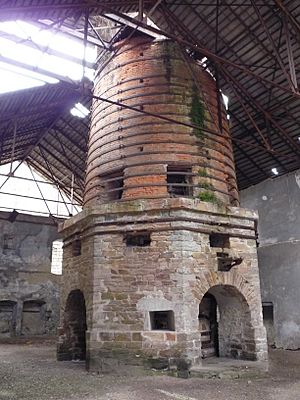Govăjdia Blast Furnace facts for kids
Quick facts for kids Govăjdia Blast Furnace |
|
|---|---|
| Native name Romanian: Furnalul din Govăjdia |
|

Octagonal stone base, conical brick body wrapped in iron girdles, dotted with blast holes.
|
|
| Location | Govăjdia village, Ghelari Commune, Hunedoara County, Transylvania region |
| Built | 1806–1813 |
| Rebuilt | 1851 (modified) |
|
Monument istoric
|
|
| Type | monument of industrial architecture |
| Designated | 2000 |
| Part of | Historic monuments in Hunedoara County |
| Reference no. | LMI Code: HD-II-m-A-03322 |
| Country | |
| Lua error in Module:Location_map at line 420: attempt to index field 'wikibase' (a nil value). | |
The Govăjdia Blast Furnace is a very old, unused furnace in Govăjdia village, Romania. It's a special type of oven used to make cast iron from iron ore. This furnace is located in the Transylvania region. It is considered a very important historical site.
Building the Giant Furnace
Before the Govăjdia furnace, there was another one at Toplița. But it couldn't make enough iron for the workshops nearby. So, in 1802, the Austrian authorities decided to build a new, bigger furnace. They chose a good spot where two rivers met. This area was also close to iron mines and workshops.
Building the furnace started in 1806. It was finished in 1810. However, it only began making iron in April 1813. This was because other important buildings, called annexes, needed to be ready first. A stone tablet on the front of the furnace says: Augusto Imperante Francisco Extructum 1810. This means "Built 1810 during the reign of the venerable Francis".
How the Furnace Worked
The Govăjdia furnace was used for about seven and a half months at first. It made a lot of cast iron, enough to last the workshops for three years! In total, it produced over 1,380 tons of cast iron.
Over the next century, the furnace was used, repaired, and sometimes left alone. In 1837, a fire damaged it. A lot of money was spent to fix it. The furnace was made bigger, and its water wheel was repaired. The machine that blew air into the furnace, called a bellows compressor, was also improved.
On August 25, 1840, a new machine called an air preheater started working. This machine made the furnace even more efficient.
The First Railway
In 1841, something very special was added: a narrow gauge railway. This railway was used to carry iron ore to the top of the furnace. Small wagons would load the ore and send it down into the furnace. This was much better than the old way of using ramps.
The railway was about 247 meters long. It was made from cast iron produced right there at Govăjdia. This was the first railway of its kind in Transylvania! Later, in 1900, it was extended to Hunedoara.
The cooling systems and the way the furnace was loaded were very advanced for that time. The furnace worked hardest between 1871 and 1889.
The Eiffel Tower Legend
There's a popular story that says metal from Govăjdia, along with metal from the Reșița works, was used to build the famous Eiffel Tower in Paris. This is a cool idea, but there's no proof that it's true. It's just a legend!
Why it Closed Down
After 1896, the furnace was used less often. This was because a new, big steel factory, the Hunedoara Steel Works, opened nearby. The last repairs to the Govăjdia furnace were made between 1914 and 1916. The very last batch of cast iron came out in 1918. The furnace officially closed forever in 1924.
In 2008, the local town hall of Ghelari took over the site. The previous owner, Hunedoara Steel Works, had not paid taxes on the property. As of 2010, the tall chimney was still standing. The original iron bands around the furnace were also still there. However, the roof needed a lot of repair, and there was some trash around the site. Luckily, the inside of the furnace was quite clean.
See also
Gallery








